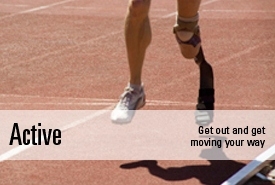by NCPAD January 30, 2013
The True Meaning of Sedentary
The start of a new year sparks considerable conversation on losing weight, exercising more, and eating a healthier diet. While these are great stepping stones to leading a healthier lifestyle, they may not be enough to ward off chronic health conditions and mortality. Recent research findings are revealing that sitting too much during the day can be detrimental to an individual's health regardless of whether or not they meet the Physical Activity Guidelines for Americans. Today's society is consumed with advanced technology and a focus on convenience, which ultimately contributes to sedentary lifestyles among Americans. Fortunately, this sedentary lifestyle can be counteracted by adding in more movement throughout the day.

Health of People with Disabilities
There are approximately 54 million Americans with some type of disability. This amounts to about 20% of the population. Many consider health and disability and oxymoron, but in fact, persons with disabilities can lead healthy, active lifestyles when given the appropriate inclusive environment to succeed. The rate of obesity is far greater for both children and adults with disabilities than for the general population. 56% of people with disabilities do not engage in any leisure time physical activity, and 87% of people with disabilities experience at least one secondary condition. Self-reported health status is classified as poor in 37% of persons with disabilities compared to 8% in persons without disabilities. Physical inactivity and sedentary behavior is a national epidemic, but noticed more particularly in persons with disabilities due to few health professionals promoting regular physical activity for persons with disabilities, and a lack of community and health promotion programs inclusive of persons with disabilities. In order to develop a healthy, inclusive community, health messaging must include persons with disabilities. Below are strategies for creating an action plan to combat sedentary behavior and physical inactivity for everyone by adding movement in to the daily routine.
An Action Plan for Everyone
Simple adjustments to the daily routine can help make activity a default versus just an option. Get going and move more for an overall better health status.
In the workplace
- If you are able to, try actively communiting to work by riding a bike or walking/wheeling. Inclusive communities that utilize Complete Streets are a win-win for everyone!
- Make sure to always have a bottle of water at your desk. This will put you one step closer to achieving your recommended daily amount of water intake and will force you to have to get up to go to the bathroom.
- Try walking/wheeling meetings instead of seated ones. The activity might just spark some new found creativity!
- Utilize your lunch break for physical activity. Cut your lunch break in half so the other half can be filled with some kind of exercise. Midday activity helps you to wake up your brain, and may help to avoid that 2:00 p.m. burnout. Physical activity options include starting a walking club with coworkers or going to your local gym for a midday group fitness class.
- Pace around your office while on a conference call.
- Instead of emailing a co-worker, get up from your desk and converse in person.
In daily life

- A pedometer is a great tool to monitor physical activity throughout the day. Achieving 10,000 steps may not be appropriate for everyone, so wear your pedometer to track movement on day one to achieve a baseline, and aim to increase that baseline each day.
- Pets are great life companions and assets to your health. Take Fido for a walk daily to fit in some extra activity.
- There is no shame in having a favorite television show, but try moving around the house or cleaning up while watching. You can also do simple exercises during commercial breaks, such as crunches, squats, or push-ups.
- Almost any chore can be turned into a heart-pumping activity. Turn on some upbeat music and get working.
- Take advantage of family time together on the weekends, and find a park to play in, a fun race to enter, or simply take a stroll or bike ride around the neighborhood together.
The Big Picture
Aside from the Physical Activity Guidelines for Americans recommended amount of physical activity per week, it is imperative that individuals simply move more throughout the day to reduce sedentary behavior and its associated health detriments. The Physical Activity Pyramid is a great way to start assessing daily movement levels in all individuals. Looking at physical activity in these categories makes it seem more attainable and included as a factor in every person's life. Now take a stand for a better health by moving more and getting active!






